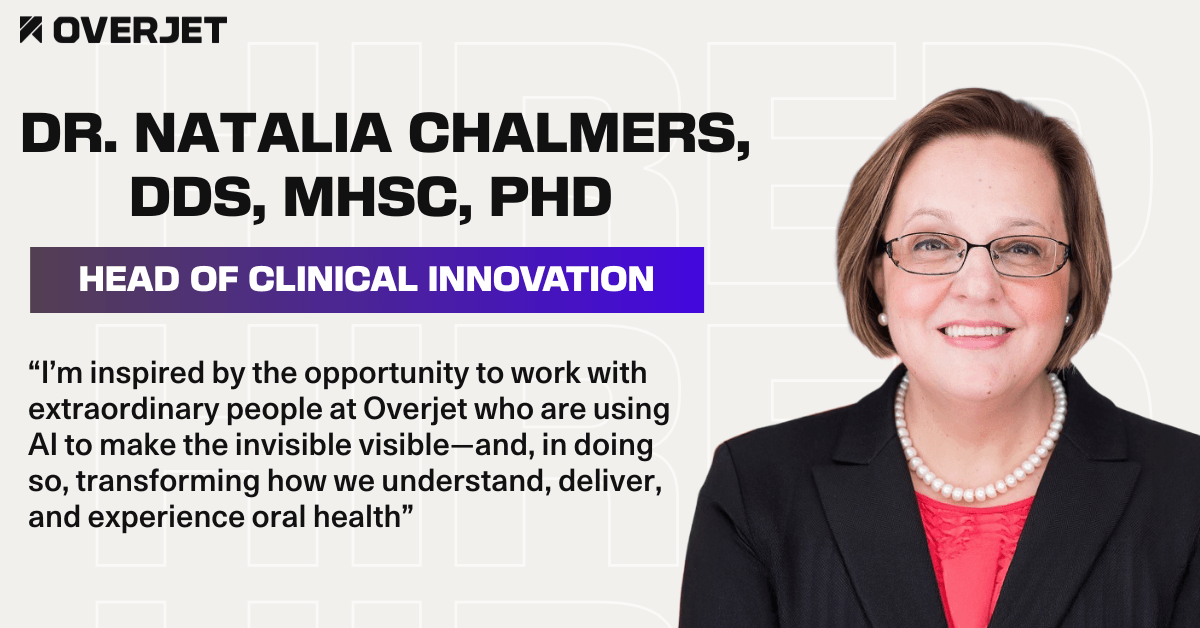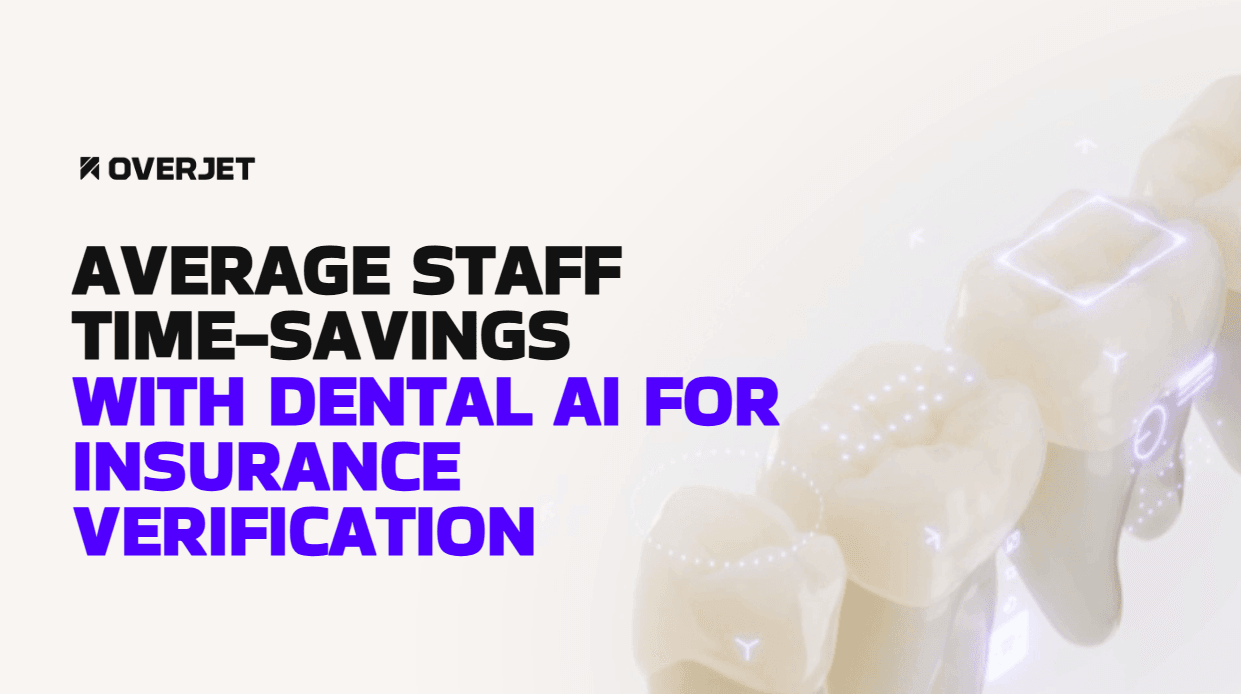In today’s dental practices, coding accuracy directly impacts financial performance. One of the most persistent challenges is downcoding—when insurance carriers reduce a submitted procedure code to a lower-cost alternative. This often leads to reduced reimbursements, financial strain, and clinical misrepresentation.
Artificial intelligence (AI) is changing the way dental practices approach this issue. With real-time diagnostics and automated documentation, Overjet helps protect clinical integrity and revenue. Here's how AI is redefining dental downcoding prevention.
Explore Overjet's Dental AI for Insurance Verification
What Is Dental Downcoding?
Dental downcoding occurs when an insurance payer modifies a submitted procedure code to a less complex—and less reimbursable—alternative. This adjustment is often made during claims processing when the documentation submitted does not meet the payer’s criteria for the original code. While intended as a cost-control measure by insurers, downcoding can have serious implications for dental practices.
Common examples of downcoding include:
Scaling and root planing (D4341/D4342) downgraded to a routine prophylaxis (D1110)
Multi-surface or complex restorations recoded as single-surface fillings
Periodontal maintenance services reclassified as standard preventive care
Downcoding doesn’t just reduce reimbursement—it can also compromise the accuracy of clinical records and misrepresent the level of care provided. When claims are downcoded, providers may be forced to absorb the revenue loss or pass additional costs to the patient, often leading to confusion or dissatisfaction.
More critically, repeated downcoding may raise questions during audits and impact the perceived quality of care across a dental service organization (DSO) or multi-site practice. Many downcoding instances stem from inconsistent documentation, lack of diagnostic support, or coding errors.
That’s why dental AI platforms like Overjet are increasingly essential—providing clear, quantifiable evidence to support submitted codes and protect against unjustified downcoding. Accurate diagnostics and AI-driven documentation help ensure procedures are correctly represented, appropriately reimbursed, and fully aligned with clinical intent.
Root Causes of Downcoding in Dental Claims
Downcoding often occurs not because the treatment was unnecessary, but because the documentation submitted fails to support the billed procedure. Most instances of downcoding can be traced back to preventable gaps in clinical records and inconsistencies in how diagnoses are documented.
Common root causes include:
Insufficient Radiographic Evidence: Insurance carriers frequently require visual proof—such as bitewings or periapicals—to justify higher-level procedures like scaling and root planing or complex restorations. When radiographs are missing or unclear, payers may default to a lower-paying code.
Incomplete or Subjective Clinical Notes: Vague language or a lack of quantifiable detail in treatment notes can make it difficult to justify the necessity of a procedure. This opens the door for payers to reinterpret the care provided.
Diagnostic Variability Among Providers: Without standardized diagnostic criteria, different clinicians may code similar findings differently. This inconsistency can lead to more scrutiny from insurance companies and increased likelihood of downcoding.
Siloed Clinical and Billing Workflows: When clinical and administrative teams operate separately, essential context can be lost during claim submission. Miscommunication or missed information often results in denials or reduced reimbursements.
Ultimately, without consistent, objective, and well-documented evidence, payers have ample room to challenge or modify submitted claims. Addressing these issues at the source—with tools like dental AI—helps ensure that clinical intent and insurance coding remain aligned, reducing the risk of downcoding.
How AI Helps Prevent Downcoding
Artificial intelligence is transforming how dental practices document and defend their clinical decisions—especially when it comes to insurance reimbursement. One of the most powerful tools in this effort is Overjet, an FDA-cleared dental AI platform that supports both diagnostics and claims integrity.
Overjet helps prevent downcoding by bringing consistency, accuracy, and transparency to the diagnostic process.
Here’s how:
Real-Time Detection: Overjet automatically identifies caries and measures bone levels on bitewings and periapicals. This gives providers objective, quantifiable data to support procedure coding—especially for scaling and root planing or periodontal treatment.
Visual Overlays: The platform displays color-coded annotations directly on radiographs, making it easy to communicate clinical findings to both patients and payers.
Standardized Metrics: Overjet quantifies disease severity, such as bone loss in millimeters, helping justify higher-level codes with concrete evidence.
Automated Documentation: Clinical insights are automatically integrated into patient records in alignment with payer expectations, reducing the likelihood of missing information during claim submission.
By replacing subjective observations with AI-backed analysis, Overjet helps dental practices generate stronger, more defensible claims. This not only minimizes the risk of downcoding but also improves reimbursement timelines, reduces administrative rework, and ensures that the care delivered is accurately reflected in billing.
In short, Overjet empowers practices to document smarter—turning diagnostic clarity into financial confidence.
Why Overjet Is the Best AI Solution for Downcoding Prevention
Preventing downcoding starts with having the right tools in place to document care accurately and consistently. Overjet stands out as the leading dental AI platform for this purpose. It’s the first and only solution FDA-cleared for both caries detection and bone level measurement—two critical indicators in periodontal and restorative care that often determine the difference between basic and advanced billing codes.
Overjet is built to integrate seamlessly with your existing systems, including major practice management software (PMS) and imaging platforms. This ensures that AI-enhanced diagnostics become a natural extension of your current workflow, without added complexity.
What makes Overjet unique in preventing downcoding:
Real-Time AI Overlays: During clinical exams, Overjet provides visual annotations directly on radiographs, helping providers identify and justify the level of care delivered.
Automated Code Alignment: The AI maps clinical findings to appropriate CDT codes, reducing guesswork and improving claim accuracy.
Dashboards for Consistency: Clinical leaders can monitor diagnostic trends and documentation quality across providers and locations, helping standardize care and reduce variability that leads to downcoding.
Trusted Across the Industry: Overjet is used by top DSOs, private practices, and dental schools—proof of its clinical and operational value.
By bridging clinical insights with billing documentation, Overjet gives practices the data and clarity they need to defend their claims and protect revenue—without sacrificing care quality.
Clinical and Financial Benefits of Using Overjet
Overjet delivers clear, measurable benefits for both clinical care and financial performance—especially when it comes to reducing downcoding.
Clinical Advantages:
More accurate diagnoses: Overjet’s FDA-cleared AI detects caries and measures bone levels in real time, ensuring no key clinical details are missed.
Clear visual explanations: Color-coded overlays help providers show patients exactly what’s happening, increasing trust and understanding.
Higher case acceptance: Patients are more likely to say “yes” to treatment when they can see the clinical need clearly.
Financial Improvements:
Fewer claim downgrades: AI-generated documentation aligns with payer requirements, reducing the risk of downcoding and denials.
Reduced appeals and rework: With complete, consistent records, billing teams spend less time chasing missing information or correcting errors.
Improved coding accuracy: Overjet standardizes how diagnoses are documented and matched to CDT codes, minimizing variability.
Better collections and cash flow: Practices report faster reimbursements and more predictable revenue cycles.
Operational Benefits:
Stronger clinical-admin alignment: AI bridges the gap between providers and billing teams, creating smoother handoffs and less friction.
Increased team efficiency: Less time spent on manual charting, documentation, and claim corrections means more time focused on patient care.
Overjet not only strengthens your claims—it strengthens your entire workflow. By uniting diagnostic accuracy with real-time documentation support, practices can boost both care quality and financial outcomes.
Real-World Success: Overjet in Action
Dental organizations across the country are seeing measurable improvements after implementing Overjet—especially when it comes to reducing downcoding and improving reimbursement outcomes.
Practices using Overjet’s AI-powered platform report:
10–20% fewer downcoded claims, thanks to objective, data-rich documentation that supports submitted procedure codes.
Improved audit readiness, with standardized diagnostics and annotated radiographs that meet payer documentation requirements.
Faster reimbursement cycles, driven by cleaner, more complete insurance submissions and fewer delays due to missing or inconsistent records.
Greater provider confidence in diagnosis, treatment planning, and code selection, thanks to real-time overlays and consistent clinical support.
By turning radiographs into clear, quantified insights, Overjet helps eliminate ambiguity in documentation—a key factor in avoiding downcoding. Teams no longer have to rely solely on subjective notes or post-visit justifications. Instead, AI delivers visual proof and standardized findings that both insurance carriers and internal QA teams can trust.
With Overjet in action, dental organizations gain more than just better claim outcomes—they build a scalable foundation for clinical and financial success.
Getting Started with Overjet
Adopting Overjet is simple, scalable, and fully supported—no matter the size or structure of your dental organization. The onboarding process is designed to ensure your team can start benefiting from AI-powered insights right away.
Here’s what to expect when getting started:
Tailored Implementation: Overjet works closely with your team to design a customized onboarding plan based on your practice management software (PMS), imaging systems, and unique operational workflows. This ensures a seamless integration with minimal disruption.
Comprehensive Training: Both clinical and billing staff receive live and on-demand training. From interpreting AI-powered overlays to using documentation tools, every team member learns how to leverage Overjet to improve efficiency and accuracy.
Performance Dashboards: Overjet provides intuitive dashboards that allow you to monitor clinical documentation quality, diagnostic consistency, and claim outcomes. These tools make it easier to identify trends, track improvements, and align teams around data-driven best practices.
Ongoing Support: Dedicated AI experts are available to provide long-term support as your practice evolves. Whether you're adding new locations or refining documentation protocols, Overjet grows with you.
From day one, Overjet empowers your practice to protect the full value of the care it provides—minimizing downcoding, strengthening claims, and creating a more streamlined path from diagnosis to reimbursement.
Let's Get Accurate Dental Coding with AI
Dental downcoding doesn’t just affect revenue—it can undermine clinical integrity and patient trust. By implementing AI tools like Overjet, practices can standardize care, support accurate coding, and confidently defend their claims. In an evolving reimbursement landscape, Overjet is the partner that ensures you get paid for the care you provide.
Ready to see Overjet's AI for Dental Insurance in Action?
FAQs - Dental Downcoding Prevention with AI
1. What is dental downcoding, and why does it happen?
Downcoding occurs when insurers replace a submitted procedure code with a lower-cost alternative, usually due to insufficient documentation.
2. Can Overjet help reduce claim denials and appeals?
Yes. Overjet automates documentation and diagnostic clarity, helping practices submit stronger, more defensible claims.
3. How does Overjet support medical necessity documentation?
Overjet provides visual overlays, quantified metrics, and AI-generated clinical notes that align with payer requirements.
4. Will AI replace my billing team?
No. Overjet enhances your team’s capabilities by automating tedious tasks and improving coding accuracy, not replacing human roles.
5. Is Overjet HIPAA-compliant and secure?
Yes. Overjet meets all HIPAA standards and is built with enterprise-grade data security protocols.









